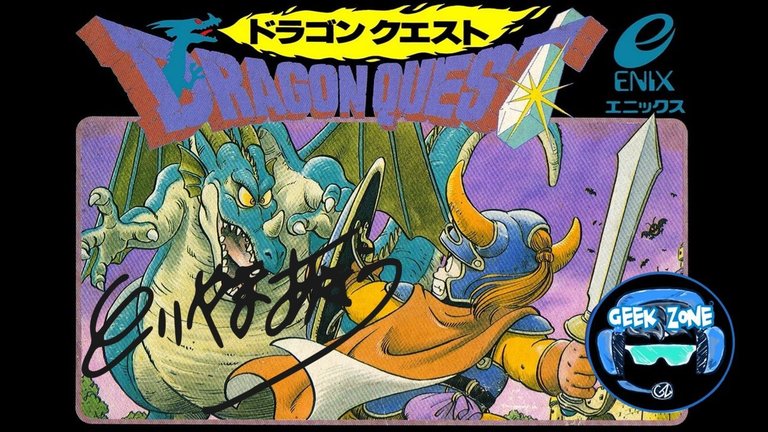
Portada creada del: Gameplay / Cover created from: Gameplay
Saludos comunidad de Geek Zone! Esperando que se encuentren bien, he querido el día de hoy hacer un homenaje a uno de los mangakas que ha dejado huella en toda esa esa generación de niños en los 90 y que en marzo de este año tomó su nube voladora y nos dejó para viajar al otro lado del sueño. Me refiero al gran maestro Akira Toriyama, comencemos!
Greetings Geek Zone community! Hoping you are all well, today I wanted to pay tribute to one of the mangakas who has left his mark on that generation of children in the 90s and who in March of this year took his flying cloud and left us to travel to the other side of the dream. I am referring to the great master Akira Toriyama, let's begin!

Este post ha sido uno que me ha hecho no sólo rememorar aquellos momentos, sino también desempolvarlos. Desde revistas, afiches, cromos y estampillas alusivas a Dragon Ball eran objetos que atesorábamos con gran cariño y es que la obra de Akira Toriyama calo tan hondo en nuestra imaginación que es imposible olvidarlo aun de adultos.
This post has been one that has made me not only remember those moments, but also dust them off. From magazines, posters, cards and stamps alluding to Dragon Ball were objects that we treasured with great affection and the fact is that Akira Toriyama's work penetrated so deeply into our imagination that it is impossible to forget it even as adults.
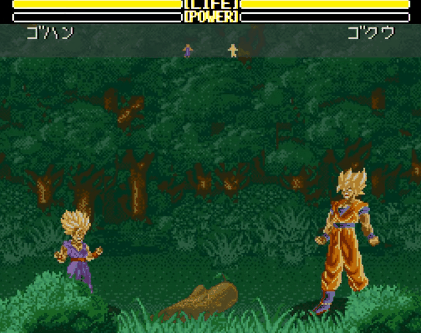
Imagenes tomadas del Gameplay/Images taken from the Gameplay
Todavía conservo mi revista Club Nintendo que hablaba sobre el juego de Dragon Ball para Snes que en realidad era la tercera entrega de este saga para la consola y que fue el único que conocimos en Occidente para la Snes.
I still have my Club Nintendo magazine that talked about the Dragon Ball game for Snes that was actually the third installment of this saga for the console and that was the only one we knew in the West for the Snes.

En esa época no se extendía el internet como ahora lo conocemos y aún así cada tarde religiosamente nos congregábamos frente al televisor para disfrutar de Dragon Ball. Por eso en marzo recibimos la noticia más amarga que jamas hayamos podido recibir, en la página oficial de Dragón Ball apareció el comunicado confirmandola, Toriyama nos habia dejado.
At that time, the Internet was not as widespread as we know it today, and yet every evening we religiously gathered in front of the television to enjoy Dragon Ball. That's why in March we received the most bitter news we could ever receive, on the official Dragon Ball website appeared the statement confirming it, Toriyama had left us.
Estos últimos 3 años han sido duros para los amantes del manga y anime, en 2021 nos dejó Kentaro Miura creador de la obra Berserk (1989), mientras que en 2023 Leiji Matsumoto creador de Obras como Space Battleship Yamato (1974) también partió al infinito. Esta es la razón de porque quise hacer esta publicación a manera de homenaje al gran maestro Toriyama.
These last 3 years have been hard for manga and anime lovers, in 2021 Kentaro Miura, creator of the work Berserk (1989), left us, while in 2023 Leiji Matsumoto, creator of works such as Space Battleship Yamato (1974), also left for infinity. This is the reason why I wanted to make this publication as a tribute to the great master Toriyama.

Akira Toriyama nació en el 5 de abril de 1955 en Nagoya Japón y personalmente es para mí después de Ozamo Tesuka y Leiji Matsumoto el mangaka más popular y que más ha sido referenciado, no sólo en Japón sino también en Occidente. Su primer gran éxito no fue Dragon Ball sino Dr. Slump en 1980 y adaptada al anime en 1981, seria ya para 1984 que Toriyama alcanzaría las puertas de la inmortalidad con el manga más popular de la historia: Dragon Ball en 1984.
Akira Toriyama was born on April 5, 1955 in Nagoya, Japan and personally, after Ozamo Tesuka and Leiji Matsumoto, he is for me the most popular and most referenced mangaka, not only in Japan but also in the West. His first big success was not Dragon Ball but Dr. Slump in 1980 and adapted to anime in 1981. It would be in 1984 that Toriyama would reach the gates of immortality with the most popular manga in history: Dragon Ball in 1984.
Ambas obras fueron publicadas por la revista Shōnen Jump, pero sería Dragón ball la que se convertiría en un fenómeno mundial. Sin embargo Akira Toriyama trabajo en más obras, su legado va más allá del manga o el anime, es aquí donde quiero centrar mi homenaje al maestro, porque Akira Toriyama es sin duda uno de los pilares fundamentales del nacimiento del JRPG través del videojuego: Dragón Quest y esta es la historia que quiero compartir con ustedes.
Both works were published by the magazine Shōnen Jump, but it would be Dragon Ball that would become a worldwide phenomenon. However, Akira Toriyama worked on more works, his legacy goes beyond manga or anime, this is where I want to focus my tribute to the master, because Akira Toriyama is undoubtedly one of the fundamental pillars of the birth of the JRPG through the video game: Dragon Quest and this is the story I want to share with you.

Imagenes tomadas del Gameplay/Images taken from the Gameplay

Enix: El inicio/Enix: The beginning

Dragon Quest fue la consecuencia de una serie de acontecimientos que condujeron a la convergencia escritores, directores y artistas en el momento, lugar y circunstancias históricas apropiadas. Entonces para entender todo el contexto debemos comenzar en 1975 cuando el empresario Yasuhiro Fukushima fundó Eidansha Boshu dedicada a los bienes raíces, no fue luego de pasar un tiempo viviendo en los EEUU que entendió el potencial de los videojuegos como mercado emergente y fue así que decidió renombrar su empresa como Enix.
Dragon Quest was the consequence of a series of events that led to the convergence of writers, directors and artists at the appropriate time, place and historical circumstances. So to understand the whole context we must start in 1975 when businessman Yasuhiro Fukushima founded Eidansha Boshu dedicated to real estate, it was not after spending some time living in the US that he understood the potential of video games as an emerging market and so he decided to rename his company as Enix
Yasuhiro Fukushima Fundador de Enix/Yasuhiro Fukushima Founder of Enix
However there was a problem, Fukushima was not only not a programmer but he also did not know professional programmers so his first decision was to hold a contest in the Shōnen Jump magazine called Enix Games Hobby Program Contest to find talents dedicated to video game programming.
Sin embargo existía un problema, Fukushima no solo no era programador sino que tampoco conocía programadores profesionales por lo que su primera desición fue realizar un concurso en la revista Shōnen Jump llamado Enix Games Hobby Program Contest para encontrar talentos dedicados a la programación de videojuegos.
Revista Shōnen Jump/Shōnen Jump magazine
De los 300 concursantes uno de ellos destacaría notablemente: Yujii Hori un aspirante a mangaka que comenzó a incursionar en la programación de videojuegos y que por azares del destino terminó trabajando para la revista Shōnen Jump donde hizo estrecha amistad con Kazuhiko Torishima editor de las obras de Akira Toriyama.
Of the 300 contestants one of them would notably stand out: Yujii Hori, an aspiring mangaka who began to venture into video game programming and who by chance ended up working for the magazine Shōnen Jump where he made close friends with Kazuhiko Torishima, editor of the works of Akira Toriyama.
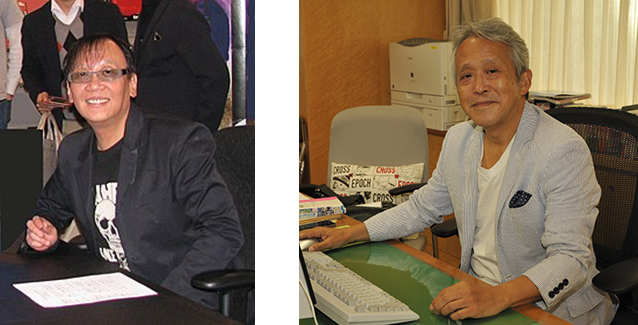
Yūji Horii & Kazuhiko Torishima
Entonces, Enix ya tenia a sus programadores que lanzaran sus primeros títulos bajo la dirección de Yujii Hori que a su vez publicaba el avances de su trabajo en la Shōnen Jump en una sección ofrecida por Kazuhiko Torishima. Si algo tenían en común Hori, Torishima y Fukushima como director de la Enix era su pasión por un tipo particular de juegos, el RPG.
So, Enix already had its programmers who released their first titles under the direction of Yujii Hori who in turn published the previews of his work in Shōnen Jump in a section offered by Kazuhiko Torishima. If there was one thing that Hori, Torishima and Fukushima as director of Enix had in common, it was their passion for a particular type of game, the RPG.

Que es un RPG?/What is an RPG?
Las siglas RPG hacen referencia a la expresion de Juego de Interpretación de Roles combinado con un conjunto de reglas en el contexto de un mundo de fantasía. Su mejor exponente es Dungeon & Dragons creado en 1974 por Gary Gygax y Dave Arnesón. El gran éxito de esta forma de juego rapidamente atrajo el interés por llevarlo a una versión en videojuegos y el pionero en este aspecto fue Rogue de 1980.
The acronym RPG refers to the expression of Role-Playing Game combined with a set of rules in the context of a fantasy world. Its best exponent is Dungeon & Dragons created in 1974 by Gary Gygax and Dave Arnesón. The great success of this form of game quickly attracted interest in bringing it to a video game version and the pioneer in this aspect was Rogue in 1980.

Rogue (1980)
Imagenes tomadas del Gameplay/Images taken from the Gameplay
Rogue fue el primer intento de trasladar el RPG de lápiz y papel a videojuegos, éste era un título donde avanzabas en mapas que se generaban proceduralmente y donde la muerte era permanente, de este juego es que surge la expresión o el genero "Rogue Like". Su fama rápidamente llevaría a la aparición de otro títulos más complejos como Ultima de 1981 donde podías modificar las stats de tu héroe.
Rogue was the first attempt to transfer the pencil and paper RPG to video games. This was a title where you advanced in procedurally generated maps and where death was permanent. This game gave rise to the expression or genre "Rogue Like." Its fame quickly led to the appearance of other more complex titles such as Ultima in 1981, where you could modify your hero's stats.
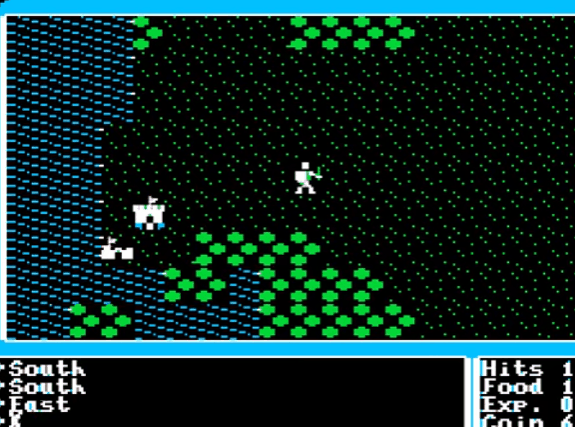

Gameplay Ultima (Origin/1981)
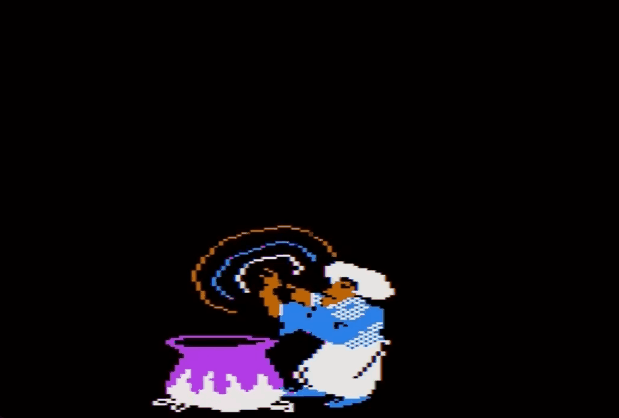
Tanto Ultima (1981) como Wizardry (1981) fueron títulos que convencieron a Fukushima y Horii que el próximo titulo de la compañía necesariamente tenía que ser un juego de rol, aunque era cierto que programar y desarrollar un juego de este tipo, decidieron correr el riesgo siendo 1983 en medio del crash de los videojuegos decidieron confiar en una debutante compañía de videojuegos en Kioto Japón: Nintendo.
Both Ultima (1981) and Wizardry (1981) were titles that convinced Fukushima and Horii that the company's next title necessarily had to be a role-playing game, although it was true that programming and developing a game of this type, they decided to take the risk in 1983, in the middle of the video game crash, they decided to trust a debuting video game company in Kyoto, Japan: Nintendo.
Nintendo Entertaiment System (1983)

Akira Toriyama y el Nacimiento del JRPG/Akira Toriyama and the Birth of the JRPG
Tanto Enix como Horii para 1983 sabían que tenían un proyecto grande entre manos que cambiaría la industria de los videojuegos, la incorporación de Koichi Sugiyama les tenía asegurada una excelente banda sonora solo faltaba el arte del juego y diseño de personajes fue alli donde el editor de la revista Shōnen Jump convence al maestro Toriyama para participar del proyecto y lo demás es historia de los videojuegos.
Both Enix and Horii knew by 1983 that they had a big project on their hands that would change the video game industry. The incorporation of Koichi Sugiyama had assured them an excellent soundtrack; all that was missing was the game's art and character design. It was there that the editor of the Shōnen Jump magazine convinced the master Toriyama to participate in the project and the rest is video game history.
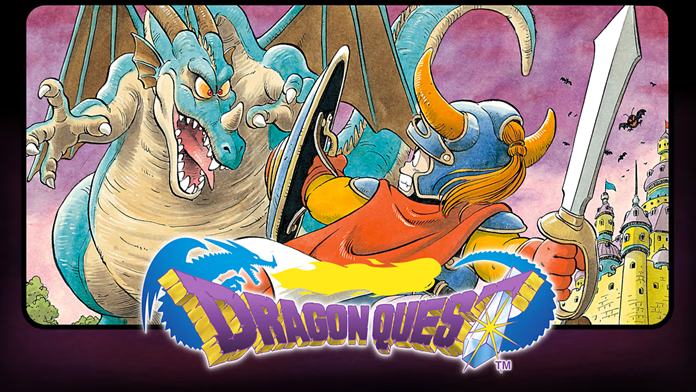
Imagenes tomadas del Gameplay/Images taken from the Gameplay
Para ese momento Akira Toriyama se había consegrado con Dr. Slump y para la etapa del desarrollo del juego ya estaba creando el manga de Dragon Ball, aun así su compromiso con este proyecto sería tal que el juego terminó convirtiéndose en algo más allá del RPG clásico, dando así nacimiento al JRPG.
By that time Akira Toriyama had established himself with Dr. Slump and by the time the game was in development he was already creating the Dragon Ball manga, but his commitment to this project was such that the game itself ended up becoming something more than just a classic RPG, thus giving birth to the JRPG.
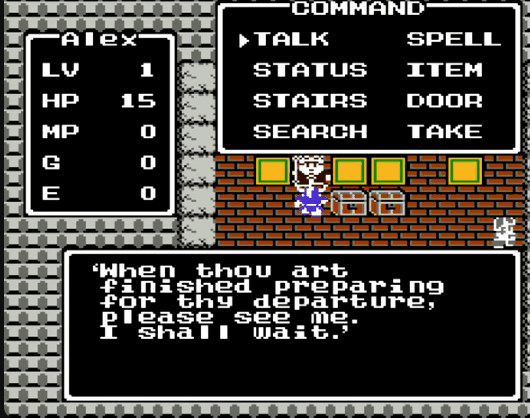

Imagenes tomadas del Gameplay/Images taken from the Gameplay
El éxito de Dragon Quest en japón fue contundente en 1986 dando a conocer la visión que tenian los japoneses del RPG uno más contemplativo y enfocado a un mayor desarrollo de los personajes. Asi, salieron otros títulos que mularon esta formula como Final Fantasy que saldría un año después convitiéndose en otro gran éxito.
Dragon Quest was a resounding success in Japan in 1986, revealing the Japanese vision of an RPG that was more contemplative and focused on greater character development. Thus, other titles came out that emulated this formula, such as Final Fantasy, which came out a year later and became another huge success.

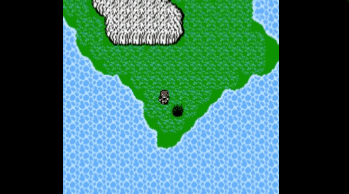
Final Fantasy (Square/1987)
Imagenes tomadas del Gameplay/Images taken from the Gameplay
Fueron 3 los títulos que saldrían para Nintendo pero la colaboración de Horii/Toriyama/Sugiyama no terminaría en Nintendo sino que continuaría hasta el Dragon Quest XI en 2017 siendo uno de los equipos de desarrollo de videojuegos más longevos de la industria.
There were 3 titles that came out for Nintendo, but the collaboration between Horii/Toriyama/Sugiyama would not end at Nintendo, but would continue until Dragon Quest XI in 2017, being one of the longest-running video game development teams in the industry.
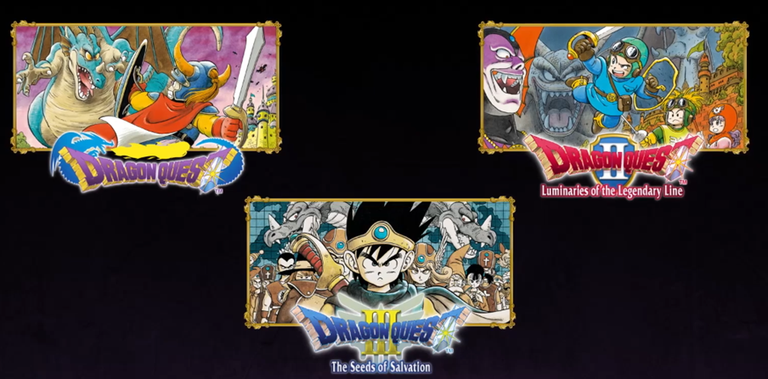
Imagenes tomadas del Gameplay/Images taken from the Gameplay

Dragon Quest no tuvo el mismo impacto en Occidente ya que por derechos de autor este juego tuvo que llegar bajo otro nombre: Dragon Warrior ya que Dungeon & Dragon tenia los derechos del titulo. Pero fue con Snes que Akira Toriyama demostraría que los videojuegos y el arte son una misma cosa con el juego JRPG: ChronoTrigger.
Dragon Quest did not have the same impact in the West, as due to copyright issues, the game had to be released under another name: Dragon Warrior, since Dungeon & Dragon owned the rights to the title. But it was with the SNES that Akira Toriyama would prove that video games and art are one and the same with the JRPG game: ChronoTrigger.
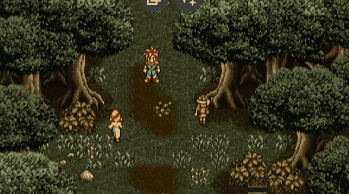

ChronoTrigger (Square/1995)
Imagenes tomadas del Gameplay/Images taken from the Gameplay
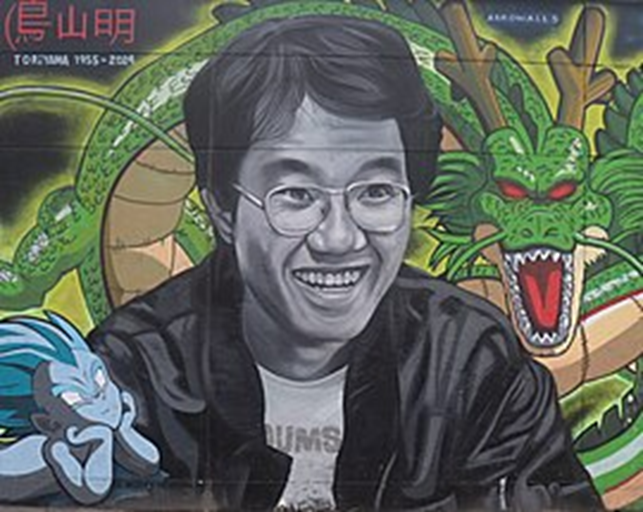
Y bien amigos con esto quiero cerrar mi homenaje al maestro Akira Toriyama que sin duda marco un antes y un después no solo en la animación japonesa, sino también un legado imborrable en la historia de los videojuegos.
And well friends, with this I want to close my tribute to the master Akira Toriyama who undoubtedly marked a before and after not only in Japanese animation, but also an indelible legacy in the history of video games.
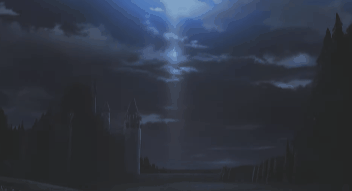
Imagenes tomadas del Gameplay/Images taken from the Gameplay
Espero que les haya gustado estas líneas tanto como a mi creando este post que forma parte de mis recuerdos de un momento en el que las cosas eran más tranquilas y disfrutar de estas historias era una verdadera delicia. Nos vemos en un próximo post. Saludos!
I hope you liked this post as much as I did creating this post that is part of my memories of a time when things were calmer and enjoying these stories was a real delight. See you in a next post. Best regards!
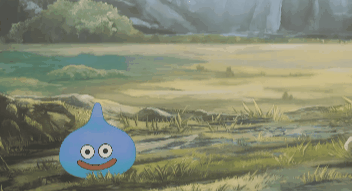
Imagenes tomadas del Gameplay/Images taken from the Gameplay

Referencias de imagenes /Image references
Comunicado Oficial DB/Official DB Statement
Arele/Dr. Slump
Logo Dragon Ball
Yasuhiro Fukushima
Shōnen Jump
Yujii Horii
Kazuhiko Torishima
D&D/TSR
Final Fantasy: The Spirits Within
NES
Akira Toriyama Mural
Todas las imágenes fueron tomadas directamente del gameplay, los gifs fueron generados usando el software screentogif. La traducción se realizó con la herramienta Deepl
All images were taken directly from the gameplay, the gifs were generated using the software screentogif. The translation was done with the Deepl tool.

Follow me on Hive!/Sigueme en Hive!
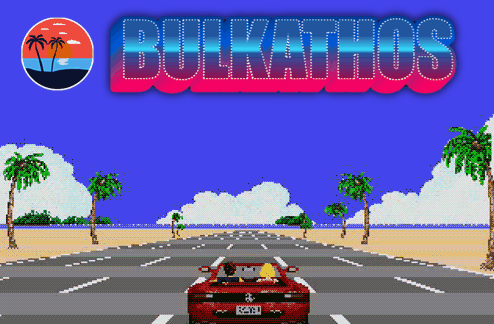
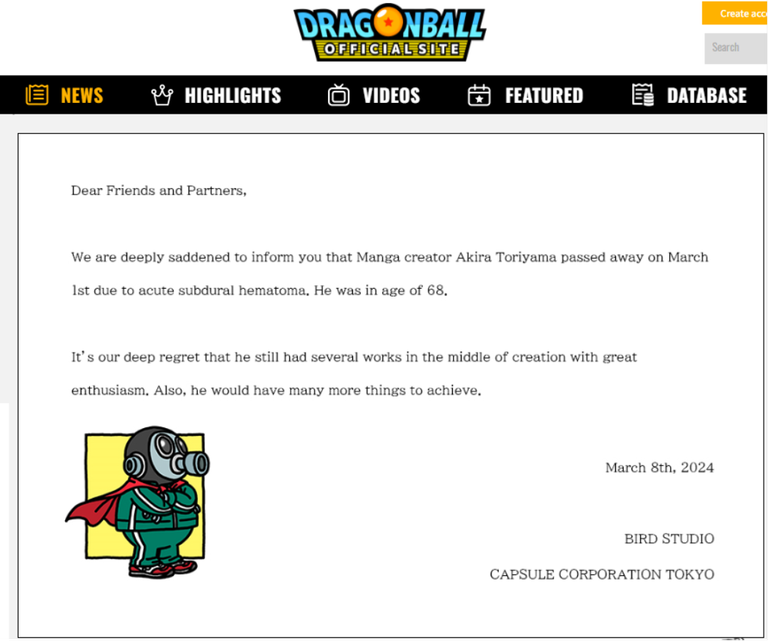


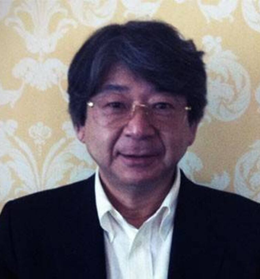
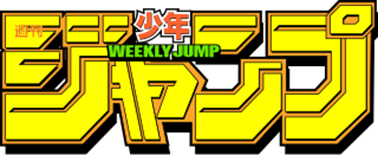
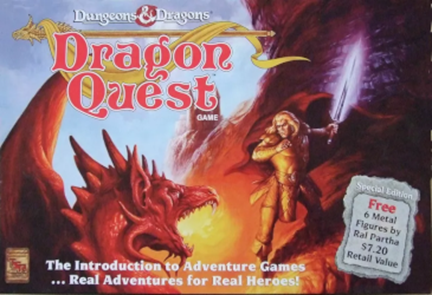
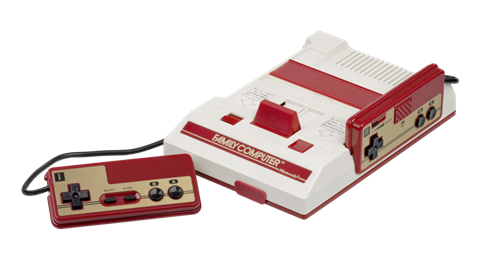
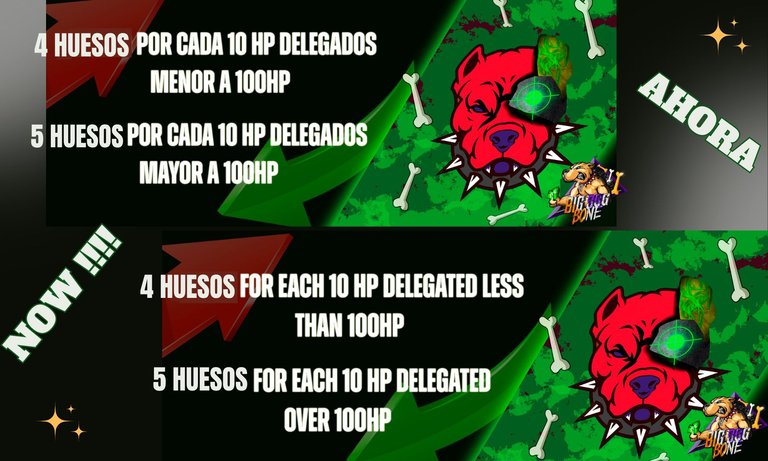


 )
)
